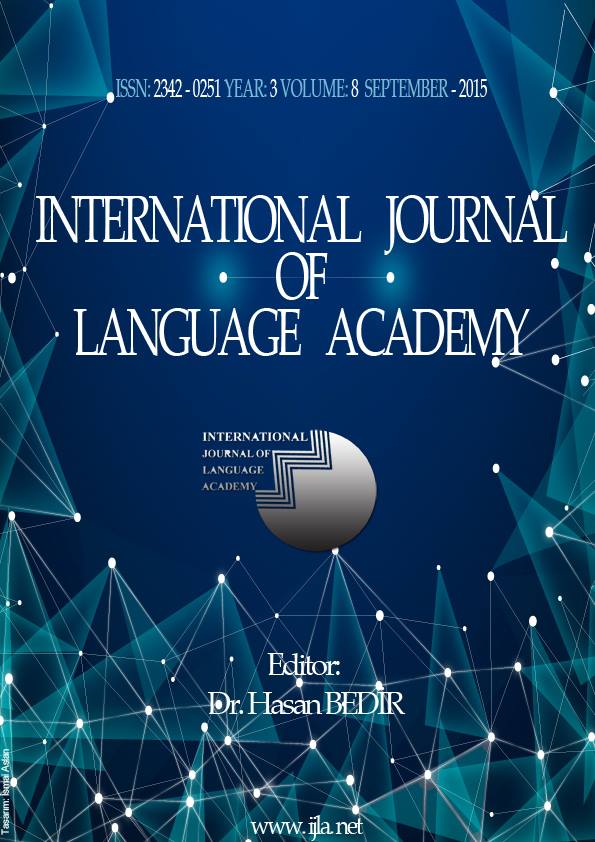Author :
Abstract
Şiirlerinde çeşitli kaynaklardan beslenen divan şairleri, ünlü sufi Hallac-ı Mansur (244/858-309/922)’a karşı da kayıtsız kalamamış, onu da şiirlerinde konu edinmişlerdir. Hak aşığı Hallac-ı Mansur’un çileli yaşamı, insanı etkileyen düşünceleri ve hazin sonu şairlerin hayal dünyasını sürekli meşgul etmiştir. Manzumelerin beyit yahut bentlerinde yer verilen Hallac hakkında müstakil eserler de kaleme alınmıştır. Bu yazıda ise bölümler halinde yazılan bir mesnevinin Hallac-ı Mansur’a ayrılan kısmı değerlendirilecektir. Eserin yazarı Edirneli Kâmî (1059/1649-1136/1724) ilim ve irfan sahibi bir şairdir. Bağdat’ta kadı olarak bulunduğu sıralarda çalışmamıza konu olan Tuhfetü’z-zevrâ mesnevisini kaleme almıştır. Şair, eserinde Bağdat’ta medfun velileri anlatmıştır. Toplam 26 başlık altında 581 beyitten oluşan mesnevi, aruzun “mef‘ûlü mefâ‘ilün fa‘ûlün” kalıbıyla yazılmıştır. Bu çalışmada, bir divan şairinin Hallac-ı Mansur’a bakış açısının incelenmesiyle, divan şiirinin beslendiği kaynaklardan birisine kapı aralanması amaçlanmış, eserin Türk kültür ve düşünce tarihine ne kadar önemli katkılar sağladığının gözler önüne serilmesi hedeflenmiştir. Bu düşüncelerle Tuhfetü’z-zevrâ mesnevisinin Hallac-ı Mansur’la ilgili bölümünün beyitleri günümüz Türkçesine çevrilerek açıklaması yapılmıştır. Edirneli Kâmî eserde Hallac-ı Mansur’u çarpıcı benzetmelerle tasvir etmiş, hayatından çeşitli kesitler sunmuş, sohbet arkadaşlarını sıralamış, düşünce dünyasını dile getirmiş ve takva yönünü anlatmıştır. Sufinin doğduğu ve yaşadığı şehirden söz etmiş fakat ünlü sözü “enelhakk”a yer vermemiştir. Hallac-ı Mansur hakkında çeşitli görüşlerin farkında olan şair, sufiye karşı olumlu kanaat sergilemiştir.
Keywords
Abstract
The Ottoman poets, feeding on various sources in their poems, could not be indifferent to famous sufic Hallaj-ı Mansur (244/858-309/922), and made him subject to their poems. The suffering life of Hallaj-ı Mansur, a God lover, his effective thoughts and his sorrowful death have always occupied the imaginary world of poets. About Hallaj, who was in the couplets or paragraphs of poems, autonomous works were written. In this text, the part of mesnevi, written in parts and which was about Hallaj-ı Mansur, will be evaluated. The author of the work, Edirneli Kami (1059/1649-1136/1724) is a man of science and wise. While he was kadi in Baghdad, he wrote the mesnevi of Tuhfetü’z-zevrâ, which is subject to our study. Poet told about buried saints in Baghdad. Mesnevi, having 26 titles and 581 couplets within it, was written in “mef‘ûlü mefâ‘ilün fa‘ûlün” of aruz wezni. In this study, it is aimed to open the doors to one of the sources which Ottoman poetry fed on through a comment of an Ottoman poet on Hallaj-ı Mansur and to present how important contributions this work has supplied to history of Turkish culture and thought. With these thoughts, the couplets of the mesnevi of Tuhfetü’z-zevrâ about Hallaj-ı Mansur have been explained by translating them into Turkish. Edirneli Kami described Hallaj-ı Mansur with striking metaphors, presented some parts of his life, told about his friends and his world of thought, and mentioned his taqwa. He talked about the birthplace of and hometown of sufi but he did not talk about his famous saying; “enelhakk”. Being aware of various thoughts about Hallaj-ı Mansur, the poet has given a positive opinion on him.
Keywords
- Abdurrahman Câmî. (2001). Nefehâtü’l-Üns Evliyâ Menkıbeleri. (Çev. Lâmiî Çelebi, Haz. Uludağ, Süleyman ve Kara, Mustafa). İstanbul: Marifet Yayınları.
- Ateş, Süleyman. (1993). Cüneyd-i Bağdâdî. TDVİA, 8, 119-121.
- Çağrıcı, Mustafa. (1997). Hakikat. TDVİA, 15, 177-178.
- Eraydın, Selçuk. (2001). Tasavvuf ve tarikatlar (Altıncı Baskı). İstanbul: M.Ü. İlahiyat Fakültesi Vakfı Yayınları.
- Feridüddin Attâr. (2002). Tezkiretü’l-evliyâ. (Çev. Uludağ, Süleyman). İstanbul: Mavi Yayıncılık.
- Gölpınarlı, Abdülbâkî. (1977). Tasavvuf’tan Dilimize Geçen Deyimler ve Atasözleri. İstanbul: İnkılâp ve Aka Yayınları.
- Hucvirî. (1996). Keşfu’l-mahcûb Hakikat Bilgisi (İkinci Baskı). (Çev. Uludağ, Süleyman). İstanbul: Dergâh Yayınları.
- Kara, Mustafa. (1994). Ebü’l-Hüseyin en-Nûrî. TDVİA, 10, 328-330.
- Massignon, M. Louis. (2006). İslâm’ın Mistik Şehidi Hallâc-ı Mansûr’un Çilesi, La Passion de Hallâj martyr mystique de I’Islam. (Çev. Birkan, İsmet). Ankara: Ardıç Yayınları.
- Öğüt, Salim. (1997). Harem. TDVİA. 16, 127-132.
- Öztürk, Yaşar Nuri. (1997). Hak ve aşk şehidi Hallâc-ı Mansûr ve eseri (Dördüncü Baskı). İstanbul: Yeni Boyut Yayınları.
- Schimmel, Annemarie. (2001). İslamın mistik boyutları. (Çev. Kocabıyık, Ergun). İstanbul: Kabalcı Yayınevi.
- Şener, Mehmet. (2001). Kabir. TDVİA. 24, 35-37.
- Tatcı, Mustafa. (2008). Niyâzî-i Kadîm Hallâc-ı Mansûr menâkıbnâmesi. İstanbul: H Yayınları.
- Uludağ, Süleyman. (1991). Amr b. Osman el-Mekkî. TDVİA, 3, 90.
- Uludağ, Süleyman. (1997). Hallâc-ı Mansûr. TDVİA, 15, 377-381.
- Uludağ, Süleyman. (2003). Makam. TDVİA, 27, 409-410.
- Uludağ, Süleyman. (2010). Sülûk. TDVİA, 38, 127-128.
- Üstüner, Kaplan. (2014). Tasavvuf ve klasik şiirimiz (İkinci Baskı). Ankara: Akçağ
- Yavuz, Yusuf Şevki. (2001). Kader. TDVİA, 24, 58-63.
- Yazıcı, Gülgün Erişen. (1998). Edirneli Kâmî ve Divanı. T.C. Kültür ve Turizm Bakanlığı e- kitap veri tabanından elde edildi.
- Yazıcı, Gülgün. (2001). Kâmî. TDVİA. 24, 279-280.
- Yıldırım, Ali. (2000). Kâmî’nin Tuhfetü’z-zevrâ Adlı Mesnevisi. Fırat Üniversitesi İlahiyat Fakültesi Dergisi, 5, 82-110.
- Yılmaz, Hasan Kâmil. (1993). Cezbe. TDVİA. 7, 504.





